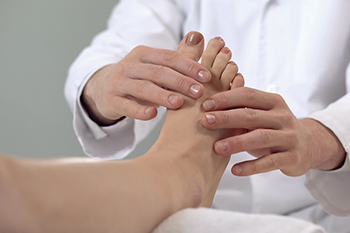
It is common to twist an ankle. It can happen from a fall, or from unexpectedly stepping off of a curb. A sprained ankle can happen for the same reasons, and it is easy to notice as the ankle becomes painful and swollen. This type of injury happens when the ligaments stretch beyond their normal range of motion, and patients may gradually develop joint pain if prompt medical attention is not received. Additional symptoms that may accompany an ankle sprain can consist of bruising and tenderness when touched. An X-ray is often performed to rule out an existing fracture, and this precedes starting the proper treatment. It begins with resting and elevating the affected foot as often as possible, and wrapping it with an elastic bandage, which may provide stability. Additionally, there are exercises that can be performed which may restore and increase the range of motion. If you have sprained your ankle, please consult with a podiatrist as quickly as possible who can determine what the best form of treatment is for you.
Although ankle sprains are common, they aren’t always minor injuries. If you need your ankle injury looked at, contact one of our podiatrists from Biebel & DeCotiis Podiatry Associates. Our doctors can provide the care you need to keep you pain-free and on your feet.
How Does an Ankle Sprain Occur?
Ankle sprains are the result of a tear in the ligaments within the ankle. These injuries may happen when you make a rapid shifting movement while your foot is planted. A less common way to sprain your ankle is when your ankle rolls inward while your foot turns outward.
What Are the Symptoms?
- Pain at the sight of the tear
- Bruising/Swelling
- Ankle area is tender to touch
- In severe cases, may hear/feel something tear
- Skin discoloration
Preventing a Sprain
- Wearing appropriate shoes for the occasion
- Stretching before exercises and sports
- Knowing your limits
Treatment of a Sprain
In many cases, the RICE method (Rest, Ice, Compression, and Elevate) is used to treat ankle sprains. However, you should see a podiatrist to see which treatment option would work best with your injury. In severe cases, surgery may be required.
It is important to ask your doctor about rehab options after you receive treatment for your injury. Stretching, strength training, and balance exercises may help the ankle heal while also preventing further injury.
If you have any questions, please feel free to contact one of our offices located in Holmdel and Middletown, NJ . We offer the newest diagnostic and treatment technologies for all your foot care needs.




